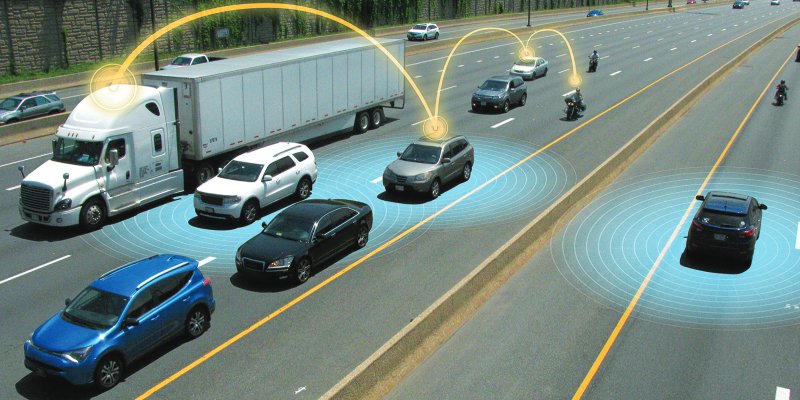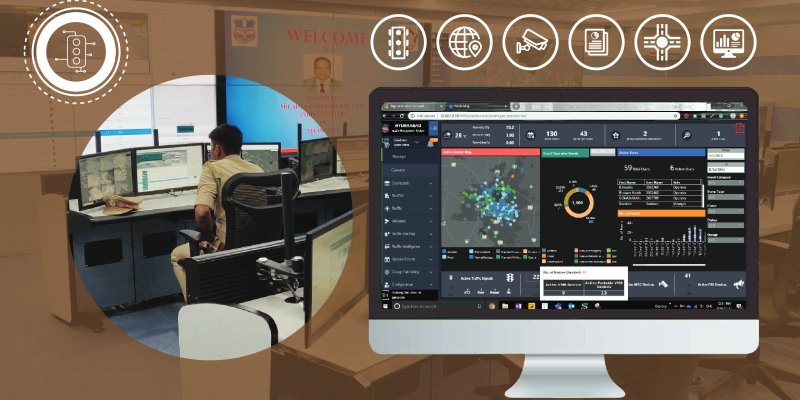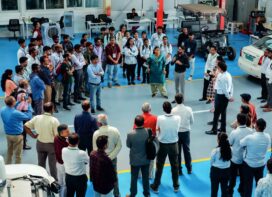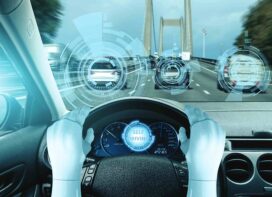An intelligent transport system (ITS) involves data collection, analyses and application of the results to develop a robust traffic management system. Along with other segments in the mobility space, ITS as a vital segment is also slowly coming back to normalcy after COVID-related disruptions. TrafficInfraTech’s Geethanjali Monto spoke to a few ITS sector leaders and academicians to gain insight into the current status and future of ITS implementation in India.


Lelitha Devi Vanajakshi
Just as in many other countries, in India also the immediate future activities in ITS area will be around connected vehicles is what I believe, ” says Lelitha Devi Vanajakshi, professor in the Department of Civil Engineering, Indian Institute of Technology Madras (IITM). She is an expert in ITS, focussing on Indian traffic conditions, and one of the core faculty members of the Center of Excellence in Urban Transport at IITM.
A connected vehicle has its own connection to the internet and is equipped with advanced communication technologies, allowing it to share data with other devices inside and outside the car. Vehicle-to-vehicle (V2V) technologies enable data exchange between vehicles (eg. on traffic conditions) while vehicle-to-infrastructure (V2I) technologies enable data exchange between vehicles and infrastructure (eg. on accidents and speed limits); vehicle-to-people (V2P) technologies enable data exchange between vehicles and smartphones or dedicated devices (eg. on ongoing activities close by) and vehicle-to-network (V2N) technologies enable data exchange between vehicles and the Traffic Control Centre (TCC) (eg. real-time information on traffic conditions).
Some of the benefits provided by connected autonomous vehicles to smart cities are portrayed in the picture.

Rajesh Krishnan
“V2V and V2I technologies are at a nascent stage in India”, says Rajesh Krishnan, Director, ITS Planners and Engineers Pvt Ltd He explains that “the technology has great potential since such technologies enable the city to exert control on traffic in a number of ways. For example, ATCS systems connected with V2I technology can influence the routing and speed of vehicles, which can lead to lower levels of congestion compared to currently-deployed ATCS systems. This is a relatively new concept, and a number of academic researchers are working on this problem. I see such technology maturing in the coming years.”

G. Satheesh
G. Satheesh, Section Head, Intelligent Transportation & Networking Section, Centre for Development of Advanced Computing (C-DAC) points out, “V2I technologies have gained momentum very recently. RFID & DSRC-based systems are the main communication technologies being used today. However there are no license bands allocated for ITS applications, which is a major challenge for large-scale deployments.
“V2V communication is emerging using DSRC and Millimeter wave technologies. But the roll out of 5G shall take momentum and will be used for both V2I & V2V technologies. Low latency is one of the major requirement for all V2I & V2V applications. In-vehicle information on the real-time traffic state and route guidance, vehicle priority for emergency service vehicles and public transport buses, onboard advisory and warning systems, vehicle platooning are some of the applications using V2I and V2V technologies.”

Rasmeet Kohli
Rasmeet Kohli, Managing Director, Envoys Electronics Pvt Ltd says that centralisation of data source and standardising the protocols for integration is key to V2V & V2I communication.
In the context of electric vehicles (EVs), what is the relevance of the ITS industry? Rasmeet Kohli provides an answer: “Electromobility and ITS are essential components in decarbonizing road transportation and play an essential role in the mobility process of Smart Cities. ITS also plays an essential task in this transformation, owing to the flexibility of the EV charging process and the EV operation, which operates as an energy storage device; it also helps to facilitate the market penetration of renewable energy resources. In parallel, IoT approaches allow the collection of large volumes of data and big data approaches, creating opportunities to develop solutions to overcome challenges such as the ones that emerge from the EV charging process, CS locations, and the reservation of charging spots.”

Satheesh points out that EV ecosystem in ITS acts as a catalyst for reduced emission and pollution.
In the last few years, there have been several innovations with respect to traffic detection, data sources and algorithms. Rajesh Krishnan says that he is happy to note that India leads the way when it comes to advanced detection technology. “We routinely use detectors that provide Vehicle By Vehicle (VBV) data or tracking (trajectory) data of vehicles using video analytics (using normal and thermal cameras) and traffic radars. Such detectors are reasonably accurate under Indian traffic conditions with lack of lane discipline. We use traffic signal controllers that can read and make use of such data while the developed world is still stuck with first generation detection technology due to legacy reasons. Our Smart City tenders set the bar high when it comes to algorithms that drive the ITS systems. Most ITS systems deployed in our Smart Cities are capable of estimating and predicting the traffic state across the road network in near real time; this is an advanced capability in the global context. Many ITS systems are capable of optimising vehicle flows measured in Passenger Car Units (PCUs). This is possible because the advanced detection used in many Smart Cities provides vehicle classification information in VBV data. This helps us to optimise the traffic flow, taking into account vehicle categories.”


Venkata Subbarao Chunduru
Satheesh talks about camera and radar-based costly solutions that are being used today for traffic count and classification, queue length detection, and speed. “Low cost sensors like WiFi and Bluetooth are also being tried out for traffic state estimation to derive vehicle density, platoon speed and queue length in a traffic junction. Classified counts of traffic in PCUs (Passenger Car Units) shall be used in traffic system design.” Venkata Subbarao Chunduru, Associate Director, IBI Group India highlights: “Camera and radar-based technologies have been most forthcoming and promising in the recent past.”
“All weather detectors are mapped with AI for increased accuracy of detection. There are data sources to further categorise the classified vehicles for efficiently optimising the timings.”, says Rasmeet Kohli.
A specific example is the Hyderabad Integrated Traffic Management Systems (H-ITMS), developed by the IBI Group India Pvt Ltd
ITMS is a control centre application, which collects data from various field sensors and different sub-systems in real time and integrates various stakeholders required for efficient handling of various operations involved in traffic management of a city. The platform contains scientifically designed and tested modules enlisted as below, which target to resolve and reduce the issues pertaining to city traffic: (1) traffic business intelligence; (2) incident management; (3) violation management; (4) traffic routing; (5) case management (TrafFix); (6) traffic management; (7) hotlist management; (8) special event management.
The highly-customizable application enables the user/city authority to appropriate it to specific standard operating procedures and adjust the extension in terms of both sensors and sub-systems without any limitation. The ITMS has been successfully implemented in the city of Hyderabad, which is now live. The system is integrated with more than 3000 field sensors and dozens of sub-systems enabling the city traffic police to effectively manage the traffic in real time and achieve their objective of cop-less junctions.
Some specific questions were posed to our experts :
Have we been successful in bringing benefits to citizens and traffic/road Have operators based on the ITS systems deployed so far?
Rajesh Krishnan: We have had some success in the context of Smart Cities. Based on evaluations carried out by some smart cities, it was shown that ATCS systems have been able to reduce congestion at specific sections of the road network. This is fantastic news, and the Smart Cities should continue to work closely with their ITS suppliers to keep their ATCS system calibrated and deliver benefit to citizens. Another success story I can see is in the area of enforcement systems. Red Light Violation Detection (RLVD) and Speed limit Violation Detection (SVD) systems are operational across the country in the past two years. We can see a tangible change in driver behaviour with increased adherence to traffic rules as a result of this in a number of Smart Cities. This is a positive change that will make our roads safer.
Rasmeet Kohli: Indeed, ITS is the only platform which is benefiting operators and road users – by creating awareness and reducing road accidents, authenticated violations and enforcements, appropriate utilisation of manpower for traffic management and operations.
Satheesh: The deployment of various ITS components in Smart Cities projects are good examples. The implementation of Adaptive Traffic Management System (ATMS) using various sensors and Integrated Automatic Traffic Enforcement Systems like Red Light Violation & Over Speed Detection system are some of the common ITS components chosen for deployment. The implementation of ATMS and Transit Signal Priority for BRT buses in Hubli–Dharwad corridor using C-DAC CoSiCoSt solution has brought in improved travel time reliability, reduction in congestion, optimised signal timing based on vehicle density and improved revenue to the client (HDBRTS Co. Ltd) in the operationalization of public transport.
Venkata Subbarao: Answer to this is not an affirmative YES. While the push from the government through Smart Cities, Digital India and allocation of funds is worth a mention, there has been a major gap in proportionate successful deployments. Mysore ITS and Hyderabad ITMS are a few success stories where we are directly involved and can vouch for results.
What are the challenges facing the ITS industry?
Satheesh: Deployment and maintenance of various sensors and infrastructure are the major challenges in ITS industry.
Rasmeet Kohli: Unless the data source is centralised and correctly integrated, it will have limited relevance for enforcement, tracking and mobility.
Rajesh Krishnan: One particular challenge I see in the industry is the lack of technically-qualified talent pool, both inside the industry and within our user base. Traffic in India is controlled by the police and we cannot manage traffic scientifically unless the people who manage traffic are technically trained. Lack of technical expertise by the end user will result in reduced performance of ITS systems. We as an industry need to actively engage with our user base and upskill them. ITS vendors abroad routinely conduct user group meetings to learn from the users and educate them; this is something we can emulate in India. Industry exhibits such as the TrafficInfraTech Expo also can play a role in this by formally bringing in ITS system users and vendors and facilitating structured interactions.
Venkata Chunduru: Most important aspect of the ITS is the planning and design of systems with right choice of technologies without bias to one particular vendor/OEM.
Second key aspect is to ensure availability of RoW for installation of field equipment, which most of the times delays the projects or prevents placement of sensors at right locations. Third point is to ensure stakeholder (especially the project sponsor/authority) awareness of the system and its utility & demand and the outcomes from each of the ITS system. Lastly, stakeholder engagement to ensure integration of people, process and system to achieve the desired outcomes.
What are the futuristic technologies that are being envisioned in ITS?
Rajesh Krishnan: Being also an academic, I see a number of new developments. I will mention a couple that we can benefit from in India. One is the use of (pseudonymised) mobile phone data from telecom operators to estimate mobility patterns of people across a city. If we understand demand patterns in temporally granular fashion, we will be better equipped to tackle congestion. The second technology is the use of fibre optic sensors along highways to detect traffic in a spatially granular fashion along the entirety of the road section using distribution acoustic sensing technology. Such sensors can detect all vehicles travelling on a highway at up to 5m spatial resolution in near real time, and they can detect accidents almost instantaneously regardless of where they happen. This will reduce the time of first response saving lives. Moreover, this technology can potentially detect near misses and harsh braking events, allowing the road operator to take preventive measures at road sections where safety is compromised before accidents actually occur; this is really exciting.
Rasmeet Kohli: Futuristic technologies will use AI and integrate them with enforcement agencies for tracking the movement of vehicles using ANPR, and then mapping with GNSS position data and sending it in real time. This can be used to address illegal activities, terrorist threats, enforcing rules on violating vehicles or impounding vehicles plying illegally on road.
Satheesh: WiFi, LiFi, Blue tooth, mmWave, 5G are some of the emerging technologies for various ITS applications.
Considering the importance of ITS in an overcrowded, polluted world, this article was an attempt to understand the ITS scenario in India and the futuristic measures that can be adopted to improve the quality of life of people with respect to mobility and traffic management.
agement.
 TrafficInfraTech Magazine Linking People Places & Progress
TrafficInfraTech Magazine Linking People Places & Progress


